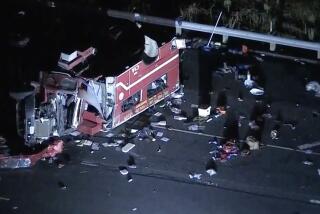Cattle to Graze Away at Fire Hazard : Wranglers Ride to Agoura’s Rescue
Their bullwhips and lariats snapping, four lanky cowboys rode Wednesday to the rescue of an Agoura neighborhood surrounded by thick stands of flammable, chest-high grass.
The wranglers moved a 300-head herd of cattle to the upwind side of the 472-home Liberty Canyon area so the animals can eat away this season’s bumper crop of wild oaks and weeds before a brush fire can sweep the field and threaten the neighborhood.
The unusual roundup was requested by Los Angeles County fire officials, who have been blocked by the state from burning a series of safety firebreaks along the Ventura Freeway in the Agoura and Calabasas areas.
Grass and brush clearance is viewed by firefighters as essential. They say fall Santa Ana winds have a history of sending brush fires through the area and across the freeway. In October, 1982, such a fire swept from Chatsworth to Malibu, burning three homes.
30-Day Moratorium
But the Fire Department’s controlled-burn program was ordered halted for 30 days Tuesday when forestry officials in Sacramento decided that conditions in Agoura and Calabasas are too hot and dry for the fires to be safely set.
“The county’s got the right idea about these controlled burns,” said Agoura rancher Al McLauren as his wranglers finished Wednesday’s two-mile cattle drive, and the hungry animals fanned out across the dry field.
“I hate to see good grass like this burn. But there’s no other way to prevent bad fires from occurring later. That 1982 brush fire cooked this area from Las Virgenes to Chesebro roads in 15 minutes. These fires always go the same way, and firemen know it. They know where to do their burns.”
McLauren said he usually keeps his cattle a mile or more from the freeway because of the danger if a one-ton steer breaks through a fence and darts into traffic. But he said he agreed to move the herd to a 100-acre field next to the freeway at Liberty Canyon Road after fire officials promised to deliver water to the site.
2,000 Gallons a Day
Firefighters have strung a fire hose over the freeway fence to fill a tank with the 2,000 gallons the cattle will drink daily as they munch out a firebreak. Fire equipment is being used to pump water into the tank.
The Colorado-born McLauren, 45, said the field has enough vegetation to keep the cattle content for about a month. After that, he is willing to discuss moving them to other nearby sites that the Fire Department needs cleared, he said.
A sheep rancher has leased the rolling ranch country north of the freeway at the Calabasas Grade, where fire officials had hoped to burn a milelong firebreak today. The sheep owner has not yet used the land for grazing, however, and his flock is expected to be moved to cornfields outside Calabasas in about two weeks, McLauren said.
Capt. Scott Franklin, head of the county Fire Department’s firebreak-burning program, said he hopes to persuade state forestry officials to lift the burning ban. He said temperature and vegetation moisture levels are closely monitored before firefighters put the torch to any growth. If conditions are dangerous, he said, he postpones that day’s burning.
Inexpensive Method
Besides being effective, firebreaks created by such controlled fires are also cheap, officials said. They cost the Fire Department about $50 an acre, contrasted with the $600 to $2,000 an acre it costs to cut grass and brush by hand. Tractor disc work and mowing costs about $300 an acre. On steep slopes, burning is often the only feasible brush-clearance method.
Wednesday’s cattle drive was welcomed by Liberty Canyon homeowners who remember fighting flames in their backyards during the 1982 blaze.
“I’m glad the cattle will be out there,” said Fran Pavley, a canyon resident who also is an Agoura Hills City Council member. “I support controlled burning, but I appreciate the concern for safety. We know what fire can do out here.”
More to Read
Sign up for Essential California
The most important California stories and recommendations in your inbox every morning.
You may occasionally receive promotional content from the Los Angeles Times.











